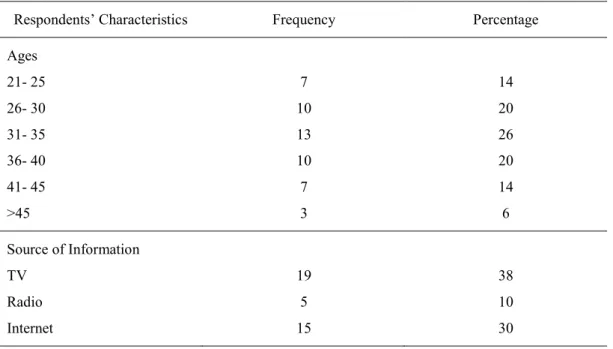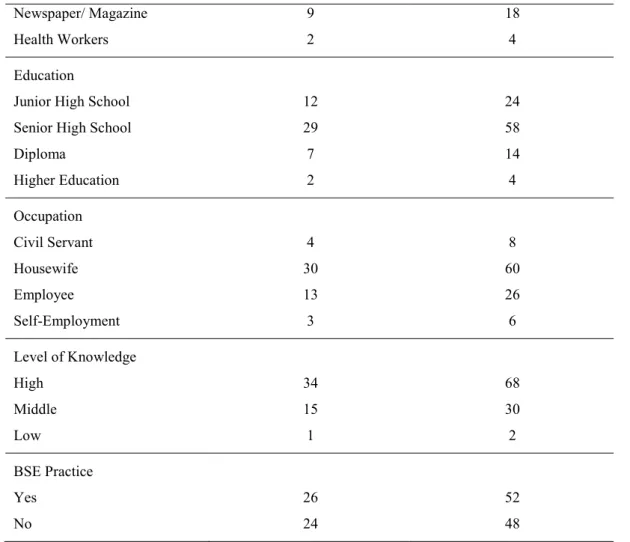HEA-OR-025
THE RELATIONSHIP BETWEEN KNOWLEDGE LEVEL AND BREAST SELF EXAMINATION PRACTICE AMONG HEALTH CADRES AT BENER, TEGAL REJO IN
2015
Ellyda Rizki Wijhati
Universitas Aisyiyah Yogyakarta, Yogyakarta, Indonesia Corresponding author‘s e-mail: ewijhati@ymail.com
Breast cancer is primary cause of women‘s death in world. Based on Basic Health Research 2013, Yogyakarta placed the first ranked of highest cancer in Indonesia. Data of Dr. Sardjito hospital reported the number of breast cancer patients throughout 2014 was 1,241 cases, the highest number of cancers throughout the period. The main cause of high mortality of breast cancer is the low knowledge and awareness of early detection of breast cancer. One of methods of early detection of breast cancer is breast self-examination (BSE). This study is an analytic survey with cross sectional approach. The population was health cadres at Bener, Tegalrejo. The sampling technique used total sampling involving 50 cadres. The data collection using questionnaires with closed questions.
According to the analysis result, Chi-Square is 2,583 and p value = 0,275 (p value > 0,05) and thus, null hypotheses is accepted. Based on the result, it can be concluded that there is no positive and significant relationship between knowledge level and BSE on cadres at Bener village, Tegalrejo district of Yogyakarta. It is suggested that health professionals improve health promotion about breast cancer and BSE.
Keywords: Awareness, Interest, BSE, Health Cadre
1. INTRODUCTION
Breast cancer is the major cause of women‘s mortality in both developed and developing countries. The World Health Organization data in 2012 reported there were 1.7 million new cases of breast cancer, 6.3 million old cases of breast cancer and with more than 500,000 deaths in 2012 only. Morbidity of breast cancer increased by more than 20% in 2008, coupled with 14% increase on mortality (WHO IARC, 2013). Based on Basic Health Research 2013, Yogyakarta Province ranked the first of the highest cancer patients in Indonesia with prevalence of 4.1% (Department of health, 2013). Data from Dr Sardjito Hospital reported the number of breast cancer throughout 2014 had reached 1,241 cases, counted as the highest incidence among other cancer cases (Wahyudi, 2014).
The main cause of the high mortality of breast cancer is the lack of knowledge and awareness of early detection of breast cancer. As a result, most cancer sufferers are found at an advanced stage and difficult to recover. One of the factors causing the low awareness of early detection of cancer according to the Director General of Disease Control and Environmental Health Prof.Dr.Agus Purwadianto MoH RI, are the myths / incorrect assumptions about the cancer itself.
Many people still believed that breast cancer are incurable, inheritaged, and with unrecognized symptoms (Ministry of Health, 2014).
With regards to cancer control strategies, the Health Office (DHO) of Yogyakarta promotes the Integrated Development Center program in villages. Yogyakarta health office will recruit health cadres and will train them how to do early detection of breast cancer. One of the easiest ways of early detection of breast cancer is by Breast Self-Examination (BSE). More than 90% of breast tumors are known solely by women through BSE (Anugraheni, 2014).
Early detection of breast cancer using BSE is highly recommended according to both health and Islam as its benefits. Allah SWT prohibits human let himself perish. Sunnah of the prophet in the history of the companions shows many efforts to take action to prevent diseases such as stated in the Quran and hadist of Rasulallah SAW. The meaning of the hadist: "and do not throw yourselves into destruction." (Al-Baqarah; 195).
Results of a preliminary study in four urban village Tegalrejo region health center in August-October 2014, showed that most of health cadres have not been informed about early detection of breast cancer and never perform BSE. Therefore, this study aims to examine the relationship between knowledge and Breast Self Examination practices among health cadres.
2. METHODOLOGY
This research is analytic survey with cross sectional approach involving 50 health cadres in Bener, Tegalrejo as total sample. The independent variable is the level of knowledge while the dependent variable is the BSE practice. Closed-ended questionnaires comprise of 21 questions related to level of knowledge was used as data collection tools.
3. RESULT AND DISCUSSION 3.1. Respondents‟ characteristics
Table 1 shows that most of health cadres were housewife aged 31-35 years old. Health information they obtained mostly from TV (38%) and only few received information from health workers. In terms of level of education, most respondents completed secondary level (29%) and only 2% attained higher education.
Table 1. The Distribution of Respondents‘ characteristics
Respondents‘ Characteristics Frequency Percentage
Ages 21- 25 26- 30 31- 35 36- 40 41- 45
>45
7 10 13 10 7 3
14 20 26 20 14 6 Source of Information
TV Radio Internet
19 5 15
38 10 30
Newspaper/ Magazine Health Workers
9 2
18 4 Education
Junior High School Senior High School Diploma
Higher Education
12 29 7 2
24 58 14 4 Occupation
Civil Servant Housewife Employee Self-Employment
4 30 13 3
8 60 26 6 Level of Knowledge
High Middle Low
34 15 1
68 30 2 BSE Practice
Yes No
26 24
52 48
Theoretically, knowledge level will influence one‘s behavior. Crosstabulation between knowledge level and BSE practice showed that of those who have good knowledge (40%) are more likely to practice BSE. Nevertheless, 28% of cadres who have good knowledge did not practicing BSE. It should be a concern since health cadres generally have better knowledge than lay people.
Although the pattern of association between knolwedge and BSE practice seem obvious, surprisingly, chi-square test showed a p-value 0.275>0.05 which indicates there is no signficant significant relationship between the level of knowledge and BSE practice of health cadres in Bener, Tegalrejo, Yogyakarta.
Table 2 Knowledge level and BSE Practice
Knowledge Level BSE Practice Total
Yes No
Good 20
(40%) 14
(28%) 34
(68%)
Medium 6 (12%) 9
(18%)
15 (30%)
Poor 0 1 (2%) 1
(0%) (2%)
Total 26
(52%)
24 (48%)
50 (100%)
Generally, someone who has a good knowledge about breast cancer is expected to have deeper knowledge about the importance of BSE so that they can apply BSE as the effort of early cancer detection. However, the high level of breast cancer and BSE does not affect BSE practice.
This is not in line with Adisasmito‘s (2007) opinion who states that education and knowledge affects the level of health awareness and disease prevention.
It is true that relationship between knowledge level and practice sometimes inconsistent.
Unlike Adisasmito‘s finding, Bowden found high level of knowledge about breast cancer has no effect on the implementation of BSE on 14 respondents. There were more dominant factors affect the implementation of BSE on health cadres such as: social, cultural and economic, experience, age and environment. The environments which have not implemented a clean and healthy life behavior greatly influence the adoption behavior of the cadres (Bowden, 2011).
In line with Bowden, Notoatmodjo (2007) points out that knowing are the lowest cognitive domain, while the implementation is the third cognitive domain after understanding. There are health cadres who do not understand about the importance of doing regular breast self-examination and do not adopt / practicing BSE as early detection of breast cancer.
Given that nowadays, technology has developed very rapidly which leads to simplify the transfer of information to public (Mc Quail, 2000), many people obtain information about breast cancer and BSE from both printed and electronic media. Perhaps, the information given from the media accessed by the respondents in this study is not adequate. The amount of information or the content accessed from the media perhaps inadequate to support the respodents‘ behavior. However, multi source of information obtained by the society about breast cancer also leave a problem which the validity of the information is still unconfirmed. This study also showed that Posbindu program held by Health Department of Yogyakarta Province is considered ineffective to improve Health cadres‘ knowledge and comprehension in detecting early breast cancer detection and thus, evaluation in promoting BSE as a regular practice is urgently needed.
4. CONCLUSION
There is no significant relationship between the level of knowledge and the implementation of BSE (p value = 0.275). The better knowledge of the health cadre about breast cancer does not ensure the participation of cadres to perform BSE.
BIBLIOGRAPHY
1. Adisasmito, Wiku (2007). Sistem Kesehatan, Raja Grafindo Persada: Jakarta
2. Anonim, (2014). Deteksi Dini Kanker Payudara. Yayasan Kanker Indonesia: . Jakarta
3. Anugraheni, Ekasanti (2014). KasusKanker di DIY TertinggiNasional.http://jogja.tribunnews.com/.
DiuploadJuli 2014
4. Aziz (2007). Riset Keperawatan dan Teknik Penulisan Ilmiah. Edisi Pertama. Salemba Medika: . Jakarta
5. Bungin, Burhan (2001). Erotica Media Massa Muhammadiyah University Press: . Surakarta 6. Depkes (2013). Riset Kesehatan Dasar. www. depkes.go.id
7. Bowden& Manning (2011). Promosi Kesehatan Dalam Kebidanan Prinsip dan Praktik. EGC: Jakarta
8. Dalyono (2010). Psikologi pendidikan. Rineka Cipta: Jakarta
9. Depkes (2008). Modul Pelatihan Bagi Tenaga Promosi Kesehatan di Puskesmas. Departemen Kesehatan RI
10. Dixon, J.M. & Leonard, R.C.F (2006). Kelainan Payudara. Dian Rakyat: Jakarta 11. Fitria, A. (2007). Panduan Lengkap Kesehatan Wanita. Gala Ilmu Semesta: Jakarta 12. Hurlock, E.B., (2002). Psikologi Perkembangan. Erlangga: Jakarta
13. Karsidi, Ravik. (2009). Perubahan Perilaku. Universitas Negri Sebelas Maret.
http://ravik.staff.uns.ac.id. Diunduh tanggal 1 Januari 2015
14. Kemenkes RI. (2011). Pedoman Penyelenggaraan Pelatihan Kader Kesehatan Kerja. Kemenkes RI:
Jakarta
15. Kisanti, A. (2007). Buku Pintar Wanita. Araska: Jakarta
16. Kompas, (2010),Agar terhindar kanker payudara,http://kompas.com /news/read/185192-agar- terhindar-kanker-payudara diunduh tanggal 1 November 2010
17. Luwia, M.S., (2003). Problematik dan Perawatan Payudara. Kanan Pustaka: Depok 18. Maulani. (2009). Kanker Payudara dan Solusinya. Media Aesclapius: Jakarta 19. Mc Quail, Denis. (2000). Mass Communicaion Theories. Sage Publication: London
20. Mubarak, I.W., Chayatin, N., Rozikin, K., Supradi. (2007). Promosi Kesehatan. Jakarta: Graha Ilmu 21. Notoatmodjo. (2005). Metode Penelitian Kesehatan. Rineka Cipta: Jakarta
22. Notoatmodjo, S. (2007). Promosi Kesehatan dan Ilmu Perilaku Kesehatan. Rineka Cipta: Jakarta 23. Novita & Fransiska. (2011). Promosi Ksehatan Dalam Pelayanan Kebidanan. Salemba Medika: Jakarta 24. Otto, Shirley E. (2003). Buku Saku Keperawatan Onkologi. Alih bahasa Jane Freyana Budi. EGC:
Jakarta
25. Prawiroharo, Sarwono. (2008). Ilmu Kebidanan. YBPSP: Jakarta 26. Purwanto. (2007). Psikologi Pendidikan. Remaja Rosdakarya: Bandung
27. Santrock, John W. (2003). Adolescence Perkembangan Remaja. Erlangga: Jakarta 28. Sugiyono, 2007. Statistik untuk Penelitian. Bandung: Alfabeta.
29. Taufik, M., (2007). Prinsip-Prinsip Promosi Kesehatan Dalam Bidang Keperawatan, Jakarta : Informedia.
30. Wahyudi, Arif. (2014) Obati Kanker tunggu setahun RSUP Sardjito Overload Pasien.HarianJogjaedisiMinggu, wage 16 November 20114
31. WHO InternationaL Agency for research of cancer (IARC), (2013). Latest World Cancer Statistics Global Cancer Burden Rises To 14.1 Million New Cases In 2012: Marked Increase In Breast Cancers Must Be Addressed. www.who.go.id, diakses 12 November 2014

